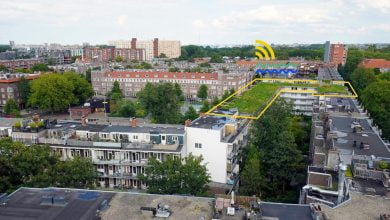The new European Bauhaus initiative plans to integrate the principles of the European Green Deal into our lives through the harmonious fusion of culture, architecture and design.
The new European Bauhaus movement was launched two years ago gaining significant interest from the construction and architecture industry but not so much from the general public and media.
- Original Bauhaus Movement
- Three main principles of New European Bauhaus
- The Mind Behind New European Bauhaus Movement
- Concept of Sustainable European Future
- European Green Deal
- New European Bauhaus Prizes 2023
- New European Bauhaus Booster 2.0
- IFLA Conference in Brussels
- Policymakers Not Happy with the Progress of NEB
Original Bauhaus Movement
The original Bauhaus movement that started in the German art school of Weimer in 1919, became the inspiration for the revolutionary new European Bauhaus initiative. The movement provided the basis for the seamless integration of aesthetics and functionality. It blended mass production with individual artistic vision to create a perfect union.
Walter Gropius was a visionary man who founded ‘Bauhaus’. The german word ‘Bauhaus’ means ‘Building House’. He came up with the idea of “Gesamtkunstwerk” which means “a total work of art.”
He wanted to design everyday objects, furniture, and buildings in the form of art.
The launch of the new European Bauhaus took its inspiration from the original Bauhaus and aims to make things beautiful for the environment and the people living in Europe. It’s about focusing on equality, sustainable development, and minimizing the harm done to the environment by conserving energy.
The New European Bauhaus utilizes art, circular economy, and social inclusion to accomplish the goals of decarbonization, social equality, and long-term prosperity.
This movement is not just about creating beautiful buildings and objects, it’s about creating a sustainable and equitable future for all Europeans.

Three main principles of New European Bauhaus
The New Bauhaus has 3 main principles: sustainability, inclusivity, and aesthetics. These principles work together to create an equitable and beautiful existence which is in harmony with our world.
Inclusivity means creating spaces accessible to everyone. In an inclusive space, diverse cultures, disciplines, genders and ages can come together to share ideas and collaborate. It also involves creating an economy that is more inclusive, with a fair distribution of money among the people.
Sustainability means designing solutions that are in harmony with the ecosystem of the planet. Its basis is the creation of regenerative systems based on natural cycles that restore resources while protecting biodiversity.
Aesthetics means making lives better through art, and culture and using diversity as a chance to learn and grow. It also implies that design should be beautiful and have practical form functions as well, and this should be a principle in all projects.
The Mind Behind New European Bauhaus Movement
Hans Joachim Schellnhuber, also known as John, is a German scientist and founding director of the Potsdam Institute for Climate Impact Research. He is the mind behind the movement and is known for his works on climate change. He used his knowledge and understanding of climate change to make the New European Bauhaus (NEB) more important and urgent.
Concept of Sustainable European Future
Schellnhuber had the chance to meet the leader of the European Union, Ursula Von Der Leyen, a few years back while giving a lecture on Climate change and its impacts. He shared his ideas about how design and architecture can play an important role in Climate change.
They talked more about it and hence the idea of the New European Bauhaus was initiated to help create a design in Europe that helps the environment. The NEB movement will create a sustainable future across Europe in terms of design and architecture.

European Green Deal
The New European Bauhaus is an important part of the European Green Deal as Europe is on its path of reaching net-zero carbon emissions by 2050. Europe is on its journey of green and digital transformation.
New European Bauhaus Prizes 2023
The New European Bauhaus Prizes 2023 are open for members from EU countries as well as the Western Balkans.
These prizes aim to recognize and reward extraordinary initiatives with similar principles to that of the New European Bauhaus movement.
A total prize of up to EUR 30,000 will be awarded to selected projects, for the recognition of their effort in contributing towards green and digital Europe.
It is a great opportunity for individuals, organizations, and companies to showcase their innovative and impactful projects and contribute to sustainable, inclusive, and beautiful ways of living for all Europeans.
Four Categories of Prizes
- Reconnecting with nature
- Regaining a sense of belonging
- Prioritising the places and people that need the most
- The need for long-term, life-cycle thinking in the industrial ecosystem.
Three Parallel Competition Strands
The three parallel strands in each category are:
Strand A for existing and completed projects which have positive results,
Strand B for ideas by individuals under 30, and
Strand C for education and learning initiatives at different stages of development.
Total winners
The total number of winners will be 15. The jury will choose 12 winners, one from each category in each strand. Three winners will be decided through public voting (1 per strand).
All finalists will be invited to Brussels for the award ceremony and will receive a promotional package from the European Commission as well.
How to Apply for the New European Bauhaus Prize 2023
You can apply for the New European Bauhaus Prize 2023 here. The last date to apply is 31 January 2023 at 19:00 CET.
New European Bauhaus Booster 2.0
New European Bauhaus is providing an opportunity to everyone that they can showcase their game-changing ideas and receive up to EUR 50,000 in reward for their effort.
You can’t miss this chance to shape the future. Apply today!
IFLA Conference in Brussels
The International Federation of Landscape Architects (IFLA) organized a Conference in Brussels on Saturday, June 11th, 2022, as part of the New European Bauhaus (NEB) Festival. The conference, called “Reconnecting with Nature – Landscape Architects at the Forefront of Sustainable and Creative Urban Development,” brought together landscape architects from all across the world.

Landscape architects using their skills and expertise are at the forefront of the NEB movement. They are ready to implement strategies to solve the climate crisis.
This conference is a wonderful experience for attendees to learn about new developments, share their ideas, and collaborate with other professionals to create a sustainable and modern transformation.
Policymakers Not Happy with the Progress of NEB
The NEB faced lots of challenges and criticism despite receiving initial enthusiasm and support.
The NEB was not able to engage and reach each EU nation in the first year according to a report in July 2022.
People in charge of making laws in Europe stress that Further actions are needed to make the initiative more inclusive, effective and impactful. They also agree that NEB is important for making Europe a better place to live – and more need to be done for this initiative to be successful.
Read More:
The Aya: Thoughtful architectural design for homeless families in D.C.
DC Metro buses go fare-free by July 2023
Self Driving Baby Stroller ‘Ella’ Showcased at CES 2023 – costs $3300
Car-free cities: Can this concept make its way to Pakistan?
Netherlands’ Utrecht library offers cyclists to recharge their e-devices by cycling









